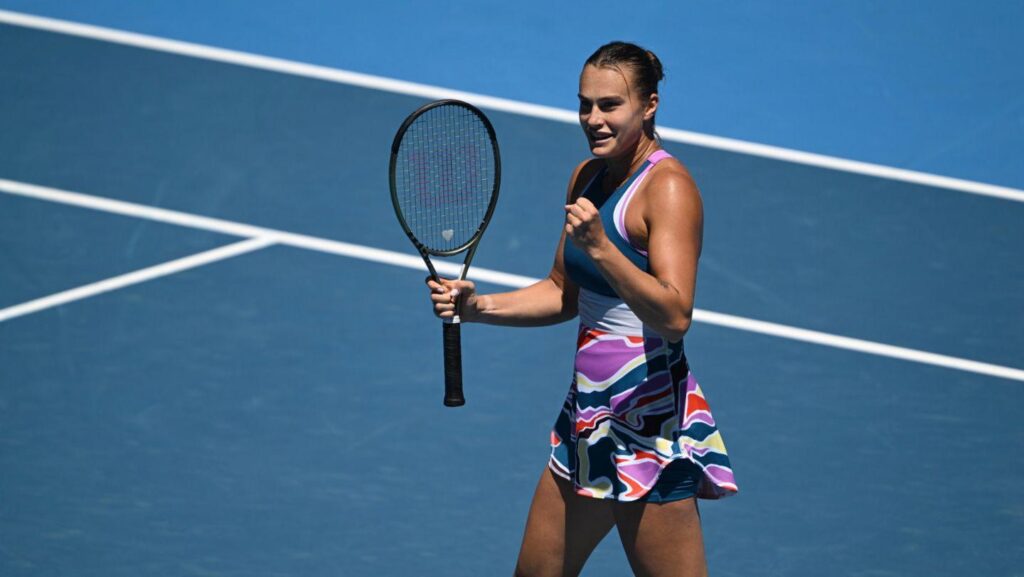Aryna Sabalenka ‚ÄčExplores‚ÄĆ the Shift to Best-of-Five‚Ā§ Sets in Women’s Grand Slam Tennis
In a thought-provoking‚ĀĘ interview that has ignited conversations ‚Äčthroughout the‚Ā§ tennis community, Aryna ‚Ā£Sabalenka, the current Grand Slam champion, expressed her views on a possible change ‚ĀĘin the format of women’s tennis. The Belarusian ‚ÄĆplayer discussed the ongoing discourse about whether grand Slam matches should transition from the‚ÄĆ traditional best-of-three sets to‚Äć a best-of-five sets ‚ĀĘformat, which is currently exclusive to men’s competitions. As tennis evolves and confronts issues of equality and competitiveness, Sabalenka’s perspective sheds light on what such a transformation could entail. This article examines her opinions alongside broader discussions within the sport.
Pros and‚Äč Cons of Adopting Best-of-Five Sets ‚Ā£for Women
Aryna Sabalenka recently articulated her stance‚Äć on possibly adopting a best-of-five ‚ÄĆsets format ‚ÄĆfor women’s Grand Slam ‚ĀĘevents. she emphasized that longer matches could considerably boost both competitiveness and excitement ‚Äčin women‚Äôs tennis. According to her, this extended format might‚ĀĘ introduce more drama into tournaments by allowing players additional chances‚Äč to showcase their resilience and strategic adjustments during intense battles. fans could‚Ā§ experience unforgettable moments,akin to those legendary‚ĀĘ encounters typically seen in men’s competitions.
However, Sabalenka also acknowledged some difficulties this change might bring. The physical toll associated‚Ā£ with playing ‚Äčfive-set ‚Äćmatches could disproportionately impact female athletes regarding injury‚ÄĆ risks ‚Äćand stamina management. Additionally, longer ‚ÄĆmatch durations may ‚ĀĘaffect viewership numbers and complicate scheduling at Grand Slam events due to potential overlaps with other matches.‚Äč With these insights, Sabalenka contributes meaningfully to an essential dialog about women’s tennis’s future while balancing enthusiasm ‚ĀĘfor innovation with an awareness ‚ĀĘof its challenges.
Impact of Format Change on Player Performance and Viewer Engagement
The discussion surrounding changing women‚Äôs Grand Slam formats raises vital questions about‚ÄĆ how it would influence player ‚Ā§performance levels. Proponents argue that extending match lengths would‚ÄĆ better ‚ĀĘreflect‚ÄĆ endurance capabilities while pushing players’ physical and mental boundaries further ‚ÄĆthan before. Such changes might necessitate alterations in‚Äč training routines ‚ÄĆas athletes focus more on stamina alongside tactical gameplay development.
On the flip side,‚Ā§ critics‚Ā£ warn about potential fatigue-related injuries ‚ÄĆamong players who may not be accustomed to ‚Äčlonger‚Ā§ formats; adapting their fitness strategies would become crucial ‚Ā£if this shift occurs.
From an audience engagement perspective, transitioning‚Äć towards longer matches could ‚ĀĘcreate more captivating narratives filled with suspenseful moments‚ÄĒallowing ‚ÄĆfor ‚Ā£dramatic‚Ā£ comebacks or thrilling finishes ‚Ā§that keep viewers glued for extended periods. However, there exists a delicate balance; consistently lengthy matches‚Ā£ may deter casual‚Ā§ fans who prefer quicker-paced contests typical of best-of-three formats. Ultimately, whether this change succeeds will depend ‚Äćheavily on players’ ‚ĀĘadaptability ‚ĀĘas well as spectators‚Äô willingness to invest time into prolonged‚Äć viewing experiences‚ÄĒpotentially ‚Äćreshaping not ‚Ā£only competitive dynamics but ‚Ā§also ‚ĀĘcultural perceptions within‚Ā£ sports.
Expert Insights & Future Directions for Women’s ‚Ā£Tennis Format Evolution
The conversation around modifying women‚Äôs tennis formats is intensifying;‚ÄĆ thus far-reaching‚Äč opinions from players have become increasingly notable in shaping future decisions regarding‚Ā£ competition structures like those ‚Äčseen at major ‚Ā£tournaments such as Wimbledon or ‚ÄćRoland ‚Ā£Garros where traditionally men play five-setters ‚ĀĘexclusively while women ‚ĀĘstick strictly three-setters only!‚Ā£ Notable‚ÄĆ figures including Aryna Sabalenka have voiced support advocating shifting‚Äć towards adopting similar standards across genders arguing it enhances overall athleticism required from competitors involved thereby increasing visibility‚ÄĆ opportunities available through showcasing skills ‚Ā§over lengthier engagements!
- Player Endurance: Evaluating how physically ‚Äćdemanding these new match lengths are likely affecting athlete performance‚Ā§ levels during playtime!
- Spectator Engagement: ‚ÄćUnderstanding viewer preferences ‚Ā£concerning match duration impacts attendance rates at live‚ĀĘ events!
- Cultural‚Ā§ Tradition vs Modernization: Balancing historical meaning against contemporary needs within evolving sporting landscapes!
- Tactical Adjustments: Assessing how shifts toward different formats influence coaching ‚ĀĘmethodologies employed by‚Äć trainers working closely alongside athletes ‚Äćpreparing them effectively ahead competitions!
| User ‚Ā§Feedback Response | % Support Level (%) |
|---|---|
| Amenable Towards Best-Of-Five Sets Adoption | 42% |
| Opposed to Best-Of-Five set Implementation | ‚ÄĆ ‚ÄĆ <38% ‚Ā£ |
| 20%< / td > ‚Äć ‚Ä謆 ¬† ‚Ā£ ‚ĀĘ ‚Äć ‚Ā£ ‚ĀĘ ‚Ā§ ‚Ā§ ‚ÄĆ ‚ÄĆ‚ÄĆ ‚ÄĆ‚Äć ‚Äć ‚Ā§ ‚Äč ‚Ā£ ‚ĀĘ ‚ĀĘ ‚Ā§ ‚Ā£ ‚ÄĆ ‚Ā£ ‚ĀĘ ‚Ā£‚Äć ‚Ā£ ‚Äč ‚Ā§ ‚Äć ‚Äč ‚ĀĘ ‚ĀĘ ‚Ā§ ‚Äć ‚ÄĆ ‚Äć ‚Ā£ ‚ÄĆ ‚ÄĆ ‚ĀĘ ‚Äč ‚ĀĘ ‚Ā£ ‚Äć ‚Äć ‚Ā£ ‚Äć ‚Äć ‚ĀĘ ‚ÄĆ ‚Äč ‚ĀĘ ‚Äć ‚ĀĘ ‚Äč ‚Ā§ ‚ÄĆ ‚Ā§ ‚Äč ‚ÄĆ ‚Ā£ ‚Ā§ ‚ĀĘ ‚Äć ‚Ā£ ‚ĀĘ ‚Äč ‚ĀĘ ‚Äć ‚ĀĘ ‚Äć ‚Äč ‚Ā£ ‚ĀĘ ‚ĀĘ ‚ĀĘ ‚ĀĘ ‚Äč ‚Ā§‚Ā§ ‚ÄĆ ‚Ā§ ‚Äč ‚Ā£ ‚ÄĆ ‚ĀĘ ‚Ā£ ‚Ā§ ‚ÄĆ ‚Ā§ ‚Äč ‚Ā§ ‚Ā£ ‚Ā£ ‚ÄĆ‚ĀĘ ‚ĀĘ ‚Äč ‚Äč ‚ĀĘ ‚Äć ‚Äč ‚Ā£ ‚Äč ‚Ā£ ‚Äč ‚ÄĆ ‚Äć ‚Ā§ ‚ÄĆ ‚ÄĆ ‚ĀĘ ‚Ā£ ‚Äć ‚Ā§ ‚Ā£ ‚ĀĘ ‚Ā£ ‚Ā§ ‚ĀĘ ‚Äč ‚Ā§ < / table > Conclusion: Navigating ‚ÄćFuture Changes TogetherAryna sabalanka’s recent remarks regarding possibly shifting towards implementing best ‚Äć-of -five set structures within grand slam tournaments have initiated significant dialogues‚Äč among‚ÄĆ stakeholders involved across various sectors ‚ĀĘrelated directly/indirectly impacting professional female athletics today!‚Äć While she reflects growing sentiments favoring evolution amongst certain circles advocating progress‚Äč forward‚Äć together collectively moving beyond traditional norms established‚ĀĘ historically over decades past‚ÄĒultimately decisions lie firmly placed upon governing bodies‚Äć overseeing regulations ensuring fairness equity remains paramount‚ĀĘ throughout all aspects concerning participation rights afforded equally irrespective gender‚Ā£ identity present therein! As discussions ‚Äćcontinue unfolding further ‚Äćdevelopments ‚ĀĘarise we eagerly ‚Äčanticipate witnessing additional voices joining chorus shaping trajectory ahead paving‚Äć way ‚ĀĘbrighter ‚Äčfutures awaiting all aspiring talents emerging onto global stage soon enough! Add A Comment |






